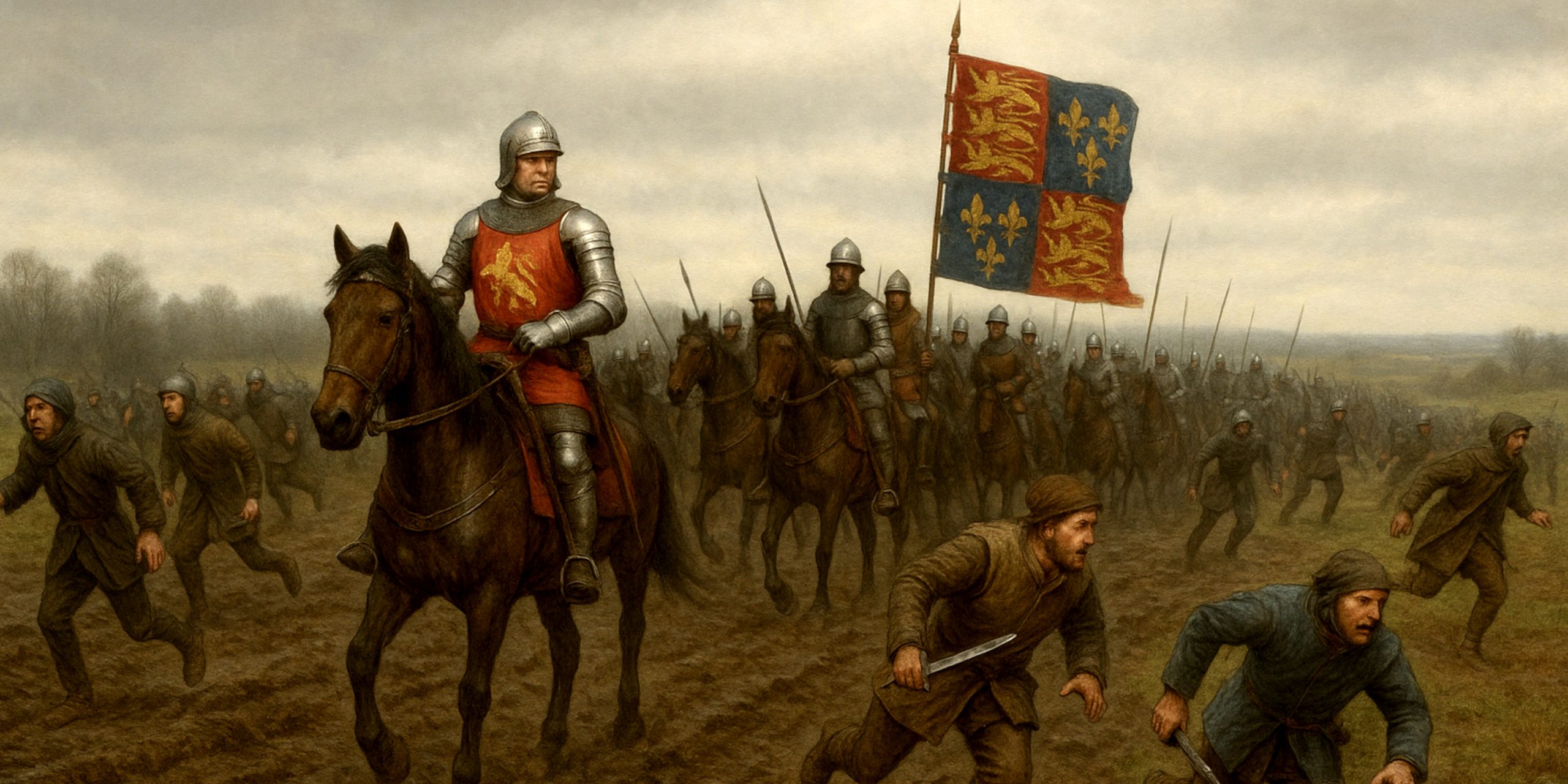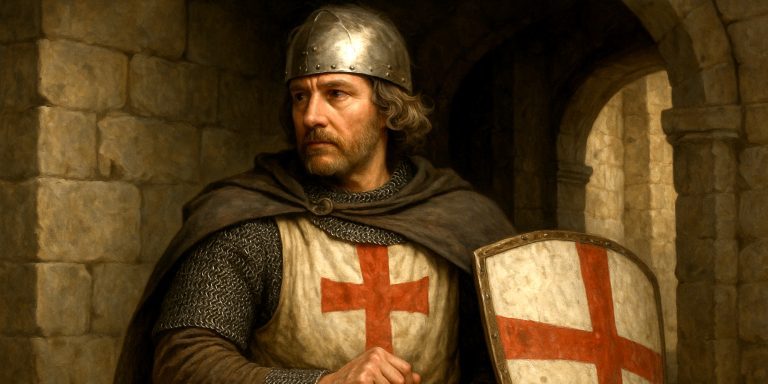
The Battle of Losecoat Field, fought on 12 March 1470 near Empingham in Rutland, was one of those curious encounters in the Wars of the Roses that ended almost as soon as it began. It was less a grand clash of arms and more a public unravelling of a rebellion that never had its heart in the fight. The confrontation saw Edward IV decisively crush an uprising led by Sir Robert Welles and other Lincolnshire rebels inspired, or perhaps misled, by the ever-calculating Earl of Warwick and the discontented Duke of Clarence.
Background
By 1470, Edward IV’s relationship with his former ally, Richard Neville, Earl of Warwick, had deteriorated into mutual suspicion. Warwick had grown frustrated with Edward’s favouritism toward the Woodville family and his refusal to marry into foreign royalty. The Duke of Clarence, Edward’s own brother, found himself drawn into Warwick’s orbit, enticed by promises of greater influence and perhaps a crown.
The immediate spark came when Warwick and Clarence secretly encouraged discontent in Lincolnshire, where local grievances over taxation and governance found ready ears. Sir Robert Welles, son of Lord Welles, raised a rebel army under the pretence of defending local liberties but in reality as part of a broader plan to pressure Edward or even dethrone him.
Unfortunately for Welles, Edward’s intelligence network functioned rather better than Warwick’s secrecy. The king marched north with remarkable speed, forcing the rebels to muster in panic near Empingham.
Forces
Royal Army (Edward IV)
| Component | Estimated Numbers | Commanders | Notes |
|---|---|---|---|
| Household troops & retainers | 5,000–7,000 | King Edward IV, William Hastings, Earl Rivers | Professional core with archers and men-at-arms |
| Northern levies (Yorkist loyalists) | 3,000 | Earl of Warwick’s former supporters now loyal to Edward | Well-equipped and disciplined |
| Cavalry & scouts | 500–700 | Sir William Parr | Used for rapid pursuit after rout |
Rebel Army (Lincolnshire Insurgents)
| Component | Estimated Numbers | Commanders | Notes |
|---|---|---|---|
| Lincolnshire levies | 4,000–5,000 | Sir Robert Welles | Poorly trained and loosely led |
| Local men-at-arms | c. 500 | Sir Thomas Dymoke | Some veterans from Towton and Barnet |
| Clarence & Warwick supporters (secret instigators) | Nominal | Earl of Warwick, Duke of Clarence | Never appeared on field; influence indirect |
Arms and Armour
By the 1470s, English soldiers were well-versed in the late medieval arsenal. The royal men-at-arms wore full plate harness, often Italian in style, with visored sallets and mail skirts. Archers favoured brigandines over padded jacks, armed with longbows of yew and side-swords of the cut-and-thrust variety.
Common Weapons Used
- Longswords: Standard knightly weapon, including Oakeshott Type XV and XVIII blades.
- Falchions: Favoured by some foot soldiers for cutting through unarmoured foes.
- Bills and poleaxes: Dominated the infantry ranks, especially among northern levies.
- Longbows: The defining English weapon, decisive when discipline held.
Rebels, by contrast, were poorly supplied. Many fought in civilian clothes with farm tools hastily repurposed, and few had proper armour. The contrast was glaring enough that one Yorkist chronicler described them as “rustics in rebellion against the crown, more fit for harvest than for war.”
The Battle
Edward’s forces reached Empingham before the rebels could form a coherent line. As the royal banners approached, Welles’s men reportedly broke before any significant exchange of blows. The king had ordered his heralds to proclaim that he would show no mercy to traitors, hardly an encouraging prelude for the rebels.
A contemporary source, the Croyland Chronicle, dryly observed that “the commons threw away their coats and fled.” This moment supposedly gave the battle its name: Losecoat Field. More likely, the name derived from “Loose Cotes,” referring to the local area, but the image of peasants shedding their garments in panic was too memorable for chroniclers to resist.
Welles was captured soon after and executed in Doncaster. Under interrogation, he confessed that Warwick and Clarence were the true instigators, forcing them to flee abroad to France where they began plotting their next move, one that would culminate later that year in Edward’s temporary deposition.
Timeline
| Date | Event |
|---|---|
| Early March 1470 | Rebellion begins in Lincolnshire under Sir Robert Welles |
| 11 March 1470 | Edward IV advances north from Stamford |
| 12 March 1470 | Royal army meets rebels near Empingham; rebels rout almost immediately |
| 13–16 March 1470 | Welles captured and executed; Warwick and Clarence flee |
| Later 1470 | Warwick allies with Margaret of Anjou, invades England; Edward temporarily deposed |
Archaeology
Losecoat Field has yielded modest finds over the years, though the site’s exact location remains debated. Metal detector surveys have recovered a few 15th-century arrowheads and buckles, but no large-scale battlefield archaeology comparable to Towton or Bosworth. The absence of mass graves supports accounts of a rapid rout rather than prolonged combat. Rutland’s gentle farmland now conceals what was essentially a rehearsal for the far bloodier confrontations yet to come.
Contemporary Quotes
“The King’s presence put all to flight, for the rebels’ courage was but smoke before the wind.”
– Paston Letters, 1470
“They were led to think that Warwick would come with strength, but none such came.”
– Croyland Chronicle
The Seven Swords Takeaway
Losecoat Field was a brief affair, but its consequences were significant. It exposed the continuing volatility of Edward’s rule and forced Warwick into open rebellion. The battle also demonstrated Edward’s command skill, swift, decisive, and personally led, a reminder that he was no passive monarch.
From a historian’s point of view, the name Losecoat rather unfairly immortalises panic rather than politics. The battle was less about cowardice than the manipulation of ordinary men by ambitious nobles who never appeared to share their fate. The peasantry paid the price, as usual, while Warwick regrouped for a far grander betrayal.



